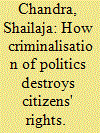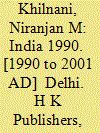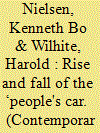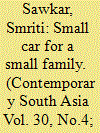| Srl | Item |
| 1 |
ID:
122448


|
|
|
|
|
| Publication |
2013.
|
| Summary/Abstract |
Most of the corruption in developing countries is inherently
political…What is labeled as corruption in developing countries mirrors
the distribution of power within societies. Few anti-corruption
campaigns dare to attack the roots of corruption in such societies as
these roots lie in the distribution of power itself."
1
This paper examines discourses on the nature and extent of
corruption in India and two factors most responsible for it. The main
argument is that unaccounted wealth and the criminalisation of politics
are responsible for important decisions being influenced by extraneous
considerations. When criminal elements hold the reins of government
they show scant concern for citizens' rights; among these the violation
of human rights not only dispossesses those in greatest need but also
brings irreversible consequences that affect generations of citizens.
|
|
|
|
|
|
|
|
|
|
|
|
|
|
|
|
| 2 |
ID:
029430


|
|
|
|
|
| Publication |
DelhI, H.K. publishers, 1990.
|
| Description |
201p.hbk
|
| Standard Number |
8185318352
|
|
|
|
|
|
|
|
|
|
|
|
Copies: C:1/I:0,R:0,Q:0
Circulation
| Accession# | Call# | Current Location | Status | Policy | Location |
| 031996 | 954.052/KHI 031996 | Main | On Shelf | General | |
|
|
|
|
| 3 |
ID:
167244


|
|
|
|
|
| Summary/Abstract |
This paper provides one of the most accurate estimates of the size of the Indian middle class, using an eclectic set of variables rooted in three major theories of class; Marxist, Weberian, and Bourdieuian. Using this original and theoretically inclusive method offers a solution to the problem of capturing the conceptual complexities of the middle class and provides a holistic examination of its composition. Through statistical analysis of the India Human Development Survey II (2011–12), the paper reveals three significant findings: firstly, it calculates the size of the middle class to be 28.05% of the urban and rural population in India. Secondly, it demonstrates that despite the occupational diversity that exists among middle classes, a large proportion of the middle class are salaried employees. Thirdly, and most importantly, it demonstrates that contrary to common assumptions in the growing literature on the middle class, a considerable segment of the Indian middle class resides in rural areas.
|
|
|
|
|
|
|
|
|
|
|
|
|
|
|
|
| 4 |
ID:
143544


|
|
|
|
|
| Summary/Abstract |
When the Indian car manufacturer Tata Motors launched its new ‘people's car’ in 2008 it was widely predicted to revolutionise automobility in India. Yet seven years after the launch, the car has barely made an impact on the Indian car market and is widely regarded as a failure. This article offers a detailed study of the rise and fall of India's ‘people's car’. Based on a mapping of the changing popular representations and symbolic imaginaries that attach to the car as a means to mobility and an object of identity and social status, we suggest that the car failed neither because it was mediocre, nor because it remained economically out of reach for most Indians. Rather, we argue that its insertion into the lower ranks of a powerful status hierarchy of identity-defining objects precluded it from adequately tapping into new and hegemonic forms of consumer aspiration in ‘New India’.
|
|
|
|
|
|
|
|
|
|
|
|
|
|
|
|
| 5 |
ID:
190162


|
|
|
|
|
| Summary/Abstract |
The Maruti Suzuki joint venture between the Government of India and the Japanese Suzuki Motor Corporation in 1983 launched India’s first ‘people’s car’ – the Maruti 800. This article argues that the conceptualisation and promotion of the Maruti 800 as the ideal car for a small, middle class family revealed subtle continuities with the controversial family planning programme of the state which had reached its peak during the internal ‘Emergency’ of 1975. By associating the Maruti 800 – an object of aspiration for an emerging middle class and of at least potential mass consumption – with a small family, the state reiterated its message of population control albeit subliminally. The article further suggests that the adoption of Japanese management practices at Maruti, which laid emphasis on hard work and loyalty to the company-family, was in line with Prime Minister Indira Gandhi’s desire to enforce discipline and enhance labour productivity, a notion also vocalised during the Emergency. Finally, the article illustrates how the ‘people’s car’ project placed the Indian state as the ‘driver’ of middle class aspirations and mobility in 1980s’ India, a full decade before the liberalisation reforms of 1991.
|
|
|
|
|
|
|
|
|
|
|
|
|
|
|
|